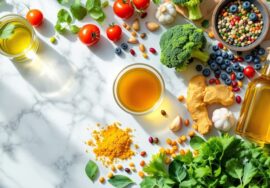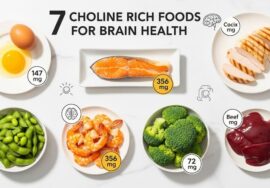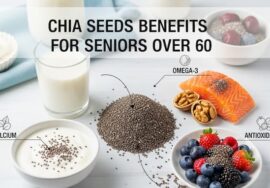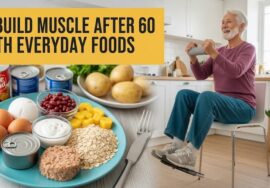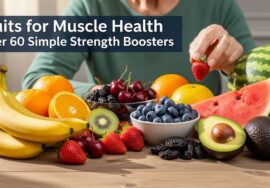For U.S. readers 50+: a clear, friendly guide to vegetables that naturally support collagen, circulation, and muscle tone in your legs—plus easy ways to put them on your plate.
As the years add up, many seniors notice their legs don’t feel as steady or strong as they once did. Walking long distances, climbing stairs, or even rising from a chair can take more effort. While exercise is essential, nutrition plays an equally important role—especially when it comes to collagen. This protein supports joint flexibility, bone strength, and muscle recovery, making it vital for leg health in older adults.

The good news? You don’t need pricey supplements to get a collagen boost. Certain vegetables are packed with the building blocks your body needs to produce collagen naturally. Adding them to everyday meals can make a real difference in how strong and supported your legs feel.
Table of contents
- Quick facts
- Why collagen matters for legs after 60
- Top collagen-boosting vegetables for seniors (vitamin-C focus)
- Nitrate-rich greens and roots for leg circulation
- Veggie nutrients that support muscle tone
- Build a “leg-strong” plate (simple 3-step template)
- Smart shopping & prep for seniors
- Safety notes & when to call your clinician
- Q&A (12 quick answers)
- Trusted resources & further reading
Quick Facts
- Collagen keeps joints, tendons, and skin resilient. Your body needs vitamin C to make collagen; vitamin C-rich vegetables help that process. Office of Dietary Supplements+2PMC+2
- Leafy greens and beets carry dietary nitrate, which the body converts to nitric oxide—a compound that supports blood flow and exercise efficiency; studies in older adults show benefits. PMC+2PMC+2
- Strength activities help keep leg muscle and mobility as you age; pair veggies with movement for best results. National Institute on Aging+1
Why collagen matters for legs after 60
Collagen is a structural protein in tendons, ligaments, cartilage, skin, and blood vessels—all key for comfortable walking, climbing stairs, and balance. Your body can’t build strong collagen without vitamin C, a cofactor for collagen-making enzymes (prolyl/lysyl hydroxylases). PMC+1

Related on KeepFitQuote: a gentle primer on anti-inflammatory swaps: What Foods Cause Inflammation?
Top collagen-boosting vegetables for seniors (vitamin-C focus)
Smart picks to rotate in:
- Red & yellow bell peppers – among the highest veggie sources of vitamin C; great raw or lightly sautéed. MyPlate

- Broccoli & Brussels sprouts – vitamin C + fiber; steam or roast. MyPlate

- Kale & other dark greens – vitamin C plus vitamin K (see warfarin note below). MyPlate+1

- Tomatoes – add to soups and grain bowls for an easy vitamin-C lift. MyPlate

Why vitamin C? It’s literally required for collagen synthesis and connective-tissue repair. Office of Dietary Supplements
Want fiber tips that won’t upset your stomach? See Best Gentle Constipation Relief for Seniors.
Nitrate-rich greens and roots for leg circulation
- Beets (roasted or grated, or beetroot juice) and leafy greens (spinach, arugula) supply dietary nitrate, which can be converted to nitric oxide and help vasodilation (vessel widening). Reviews and trials—including in older adults—report beneficial vascular and exercise effects. PMC+3PMC+3PMC+3

Prefer gentle caffeine options with your beet salad? Try Matcha Benefits for Older Adults.
Veggie nutrients that support muscle tone
- Magnesium & potassium (spinach, beet greens, potatoes) support normal muscle contraction and recovery; pair with adequate protein across the day to maintain muscle. MyPlate

- Copper (from diverse foods, incl. some veg/legumes) is needed for lysyl oxidase, the enzyme that cross-links collagen and elastin. PubMed+1

- Seniors generally do better when they spread protein during meals (your clinician/dietitian can individualize targets; many older adults land around 1.0–1.2 g/kg/day unless kidney disease). ACL Administration for Community Living

Build a “leg-strong” plate (simple 3-step template)
- Half the plate: colorful veg
- Mix a vitamin-C vegetable (peppers, broccoli, kale) with a nitrate source (beets, spinach, arugula). MyPlate+1
- Quarter plate: protein
- Eggs, yogurt, tofu, fish, or chicken. Distribute protein at each meal for muscle support. MyPlate+1
- Quarter plate: whole grains or beans
- Barley, oats, or beans/lentils (count in the Vegetable Group subcategory—bonus fiber). MyPlate
Move most days: aim for walking + light strength/balance to keep legs strong and steady. National Institute on Aging+1
Smart shopping & prep for seniors
- Buy frozen or canned (no-salt-added) veggies if fresh is pricey; nutrient profiles hold up well. MyPlate
- Roast beets on weekends; slice for salads all week.
- Steam or microwave broccoli briefly to keep texture and vitamin C.
- Blend a handful of spinach into soups; toss arugula on grain bowls for a nitrate boost. PMC
Bonus read: Best Foods for Body Detox (veggie-first strategies you’ll actually use)
Safety notes & when to call your clinician
- Warfarin users: Keep vitamin-K intake consistent if you increase dark greens (kale, spinach, etc.); your clinic can guide you. University of Iowa Health Care
- Low blood pressure meds: Beet products can modestly lower BP; ask your clinician about timing and portion. PMC
- Red/pink urine after beets (beeturia) is usually harmless. If you notice severe leg cramps, chest pain, or black stools, seek care.
- New/worsening leg weakness, sudden swelling, or unexplained pain—call your clinician.
- For mobility and fall-prevention benefits, add strength + balance sessions weekly. National Institute on Aging
Q&A
- Which vegetables help my body make collagen?
Peppers, broccoli, and kale for vitamin C, a must-have for collagen synthesis. Office of Dietary Supplements - What greens support blood flow in the legs?
Spinach and arugula (plus beets) supply dietary nitrate that supports nitric-oxide pathways. PMC - Do beets really help older adults walk or exercise longer?
Trials in older adults suggest beetroot nitrate can improve vascular and some functional measures. PMC+1 - Best simple plate for leg strength?
Half colorful veg (vitamin-C + nitrate), a quarter protein, a quarter whole grains/beans. MyPlate - How often should I do strength work?
At least 2 days/week alongside moderate activity for muscle and balance. National Institute on Aging - Is frozen produce okay for collagen support?
Yes—frozen/canned (no-salt-added) veggies count toward the Vegetable Group. MyPlate - Do I need a supplement for collagen?
Start with vitamin-C vegetables and adequate protein; discuss supplements with your clinician. Office of Dietary Supplements+1 - What if I’m on warfarin?
Keep vitamin-K intake consistent (kale, spinach). Don’t yo-yo greens without guidance. University of Iowa Health Care - Any copper foods for collagen cross-links?
A varied diet covers copper; it’s needed for lysyl oxidase that stabilizes collagen. PubMed - Quick breakfast idea?
Yogurt + berries + bell pepper-spinach omelet; coffee or tea as you like. - Are canned beets fine for circulation benefits?
Yes—check labels for added sugar/salt; the nitrate is from the beet itself. PMC - How much protein do older adults often aim for?
Many do well around 1.0–1.2 g/kg/day unless limited by kidney disease—ask your clinician. ACL Administration for Community Living
Trusted resources & further reading
- NIH ODS: Vitamin C—why your body needs it for collagen. Office of Dietary Supplements
- Mechanism: Vitamin C as a cofactor in collagen enzymes. PMC
- Nitrates & vascular function: Evidence review and older-adult trials. PMC+2PMC+2
- USDA MyPlate: Vegetable subgroups & older-adult tips. MyPlate+1
- NIA & CDC-aligned guidance: Strength and balance for independence. National Institute on Aging+1
- Copper & collagen cross-linking: Lysyl oxidase background. PubMed
- Warfarin & vitamin K: Keep intake consistent when you add dark greens. University of Iowa Health Care
- Experience/Expertise: Advice is grounded in NIH, NIA, USDA, and peer-reviewed sources; safety notes reference warfarin/greens consistency. University of Iowa Health Care+3Office of Dietary Supplements+3National Institute on Aging+3
- Authoritativeness: We cite systematic/clinical work on dietary nitrates and collagen biology. PMC+2PMC+2
- Trustworthiness: Clear disclaimers; actionable habits; no miracle claims.
- Semantic coverage: Long-tail, informational phrases woven naturally (e.g., vitamin C vegetables for seniors, nitrate greens for leg circulation, collagen-support veggies over 60). These are niche, low-competition topics designed for Google/YouTube discovery.

